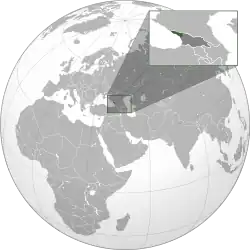 | |
| Total population | |
|---|---|
| Regions with significant populations | |
| Sukhumi | |
| Languages | |
| Hebrew, Abkhaz, Russian, Georgian | |
| Religion | |
| Judaism | |
| Related ethnic groups | |
| Jews (Ossetian Jews, Georgian Jews) |

The history of the Jews in Abkhazia dates back to the early 19th century. The Jewish population of Abkhazia consisted of Ashkenazi, Georgian and other Jews. It grew after the incorporation of Abkhazia into the Russian Empire in the middle of the 19th century. Most of the Jews left or were evacuated from Abkhazia as a result of the Georgian-Abkhazian conflict of 1992–1993.
Modern history
| Number of Jews in Sukhumi[3][4] | ||||
|---|---|---|---|---|
| Year | Total | Georgian Jews | ||
| 1897 | 134 | |||
| 1915 | 356 | 80 | ||
| 1922 | 1,012 | |||
| 1926 | 916 | 201 | ||
| 1939 | 1,545 | |||
| 1959 | ≈3,000 | ≈2,000 | ||
| 1970 | 3,618 | |||
| 1979 | 1,640 | |||
| 1989 | 1,308 | |||
| 2009 | 150 | |||
A Russian garrison was installed in Sukhumi in the 1840s, as its fortress was part of the Black Sea defence line, and Jews from many regions of Georgia, particularly from Kulashi, settled in the town. As the 1897 census results indicate, there were also many Ashkenazi Jews in Sukhumi. A synagogue was built in the first decade of the 20th century.
In Soviet times, the Jewish population of Abkhazia increased greatly, but the Sukhumi Jewish community remained the largest in Abkhazia. According to the 1926 census, there were about 1,100 Jews in Abkhazia, most of them Ashkenazi (702) or Georgian (215).[5] The Jewish community of Sukhumi was officially recognised by Soviet authorities in 1945, at the very end of World War II. Abkhazian Jews suffered like the other Jews of the Soviet Union during the massive anti-Jewish campaign in the late 1940s and early 1950s. Sukhumi synagogue was razed in October, 1951 (according to the official version, its territory was needed for urban development).[6] The Jewish population increased to about 3,500 in 1959,[7] but many of them emigrated to Israel and elsewhere in the 1970s.
As the Soviet Union was disintegrating in the late 1980s, ethnic tensions began to grow in Abkhazia and the number of Jewish emigrants increased greatly. There were still many Jews in Abkhazia at the outbreak of the Georgian-Abkhaz War in August, 1992. All of the Jews who wished to flee the fledgling republic were evacuated by the Jewish Agency and settled in Israel. Most of the few who remained were Ashkenazi.[1][8][9][10] Those who remained had to endure the capture of Sukhumi by Abkhaz separatists and their allies.[10]
As of 2009, there are about 150 Jews in Abkhazia, nearly all of them Ashkenazi. The community maintains a synagogue in Sukhumi.[10] The majority of them are elderly, with their average age being 72 in 2004.[1]
Rivka Cohen, Israel's ambassador to Georgia, visited Abkhazia in July, 2004.[10]
See also
References
- 1 2 3 Edwards, Maxim (September 30, 2012). "Jewish Life Slowly Dying in Abkhazia". The Forward. Retrieved April 22, 2013.
- ↑ "Georgia Virtual Jewish History Tour § Independence & Georgia Today". Jewish Virtual Library.
- ↑ Altshuler, Mordechai (2007). יהדות במכבש הסובייטי : בין דת לזהות יהודית בברית-המועצות, 1964–1941 (in Hebrew). Merkaz Zalman Shazar le-toldot Yiśraʼel. p. 480. ISBN 978-965-227-225-6.
- ↑ Ethno-Caucasus. Population of Abkhazia
- ↑ 1926 Census results, breakdown by ethnicities (in Russian)
- ↑ Ro'i, Yaacov; Lili Baazova (1995). Jews and Jewish Life in Russia and the Soviet Union. Routledge. p. 291. ISBN 0-7146-4619-9.
- ↑ 1959, 1970, 1979 census results for Abkhazia, breakdown by mother tongues Archived 2008-09-18 at the Wayback Machine (in Russian)
- ↑ Jewish Agency for Israel, Interview with Lev Shchegolyov, (in Russian)
- ↑ Memorial (society), Положение беженцев из Абхазии в Краснодарском крае (Situation with the refugees from Abkhazia in Krasnodar Krai), December, 2000 (in Russian)
- 1 2 3 4 Leonid Landa, Еврейская община Абхазии в круговороте кавказских событий Archived 2011-07-16 at the Wayback Machine, (Jewish community of Abkhazia in the Caucasian whirl of events), 28.09.2004 (in Russian)